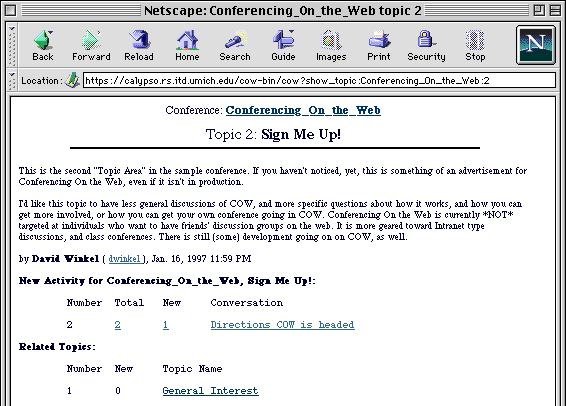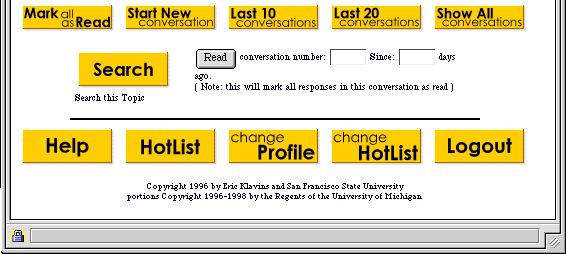

If you went into this topic to read your responses, what would you do next? That depends on whether you want to read all your responses, or only your new responses.
Quick Review of the Topic Page
In the previous section -- Looking At a Topic -- I showed an example list of new activity, as it might look on a topic page. If you look here below, you can get a better idea of how it would actually look on the page...
If you went into this topic to read your responses, what would you do next? That depends on whether you want to read all your responses, or only your new responses.
To Read All Messages, New and Old
Reading all responses is something you probably won't find yourself doing very often, so I won't go into too much detail about it. To get to a conversation page that lists all responses, you simply click on the number under the Total column in the row of the conversation you want to read. For example, if I wanted to read all the responses ever posted to the COW Directions conversation, I would click on the 2.
Choose the conversation you would like to read responses for.
- Click on the number in the New column, or
- Click on the name of the conversation
In the screenshot above, there is just one conversation, and it has one new response. This is indicated by the one in the New column.
How the Conversation Page Looks
If, according to the screenshot above, you clicked on the Directions COW is headed conversation, you would be presented with a screen like the one pictured below. You can see that there is one new response in Conversation 2: Directions COW is headed.
I'll now go over the different parts of this page and what they do:
- At the top of the page is your location. The first line tells you what conference you're in and allows you a link back to the conference page (in this case Conferencing_On_the_Web). The second line tells you what topic you're in and allows you a link back (in this case Sign Me Up!). The next line tells you, in bold, the name of the conversation (in this case: Conversation 2: Directions COW is headed). This information is useful if you use the 'Next new response' button, it will help you keep track of where you are.
- Next there's line that tells you the date and time of the last time you checked COW for new responses. All the responses below were posted after this date and time.
- Next you have several buttons:
- 'go back One Day'
This will add any responses that were posted up to one day before the last time you checked COW (one day earlier than the date/time stamp above). The responses would be added in the beginning of the page, following chronological order.
- 'go back One Week'
Same story except this goes a week back.
- 'go back One Month'
Same story except this goes a whole month back.
- 'view Entire conversation'
This button will show all the responses for the conversation, regardless of when they were posted.
- 'leave as New'
This button will leave any new responses that you read marked as new. This means that the responses will be treated as if they were new next time you view the conversation.
- 'Forget this conversation'
If you click on this button you will not see this conversation anymore on the topic page even if there are new responses in it. In addition, if there are new responses they will not be counted in the 'new responses' tally on the Hotlist. The opposite of forgetting a conversation, appropriately, is remembering a conversation. In order to do that, you must click the 'show all conversations' button on the topic page and then click into the conversation. After this the conversation will be 'remembered'.
How a response looks
The actual response is pretty straight forward. Lets take a look at the one at the top. The first thing you see is a number 2, which means that this is the second response posted to the conversation, followed by an exclamation icon. When you are posting a response you have the option of tacking on an icon for the tone of your message: question, idea, news, confused, etc. I will explain this in the Writing messages section. After this is the name of the author of the message (in parenthesis is a link to their profile page).Below that is the body of the message. In the screen shot above, the message body begins, "How do you intend to automate...". The message has a very short body in the example above, but messages can be as long as needed, and they may include lists, or links, or even graphics.
Once you enter a response, it's there for good, though you do have the opportunity to change or hide it. Hiding your response means that the number of the response will still be there, but instead of all the other stuff there will just be a line that reads: "Message is hidden". You can only hide your own responses. To hide a response, go into the conversation where your response was posted. Click the 'go back...' buttons until you see your old response. Next to the title you should see a link that reads hide/unhide. If you click that link, your response will be hidden and people will no longer be able to see the body of the response. Note: fair witnesses have the right to hide anybody's response, not just their own. I.e. your prof. can choose to hide your response!
You can also change your response by clicking on the link for "change response" next to your response. An updated time will appear next to your response. You shouldn't change responses often, because people will not see your changed response again, if they viewed the original.
The bottom of the page
The bottom of the page has the appropriate boxes and buttons for you to reply to the responses above if you would like to. I'll discuss how to do this in the next section: Writing Messages.